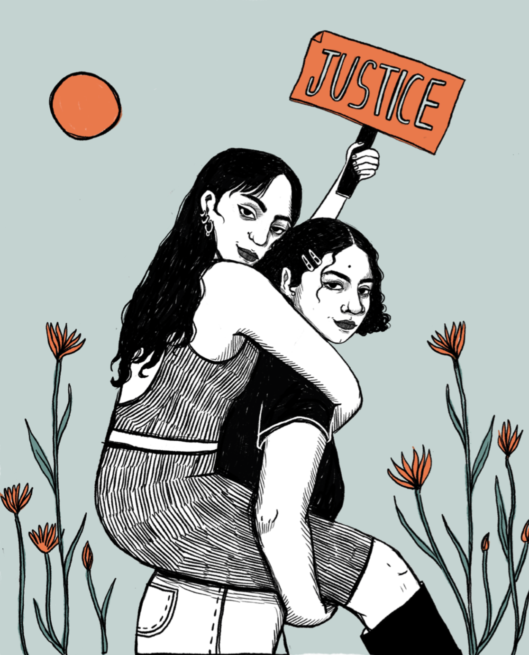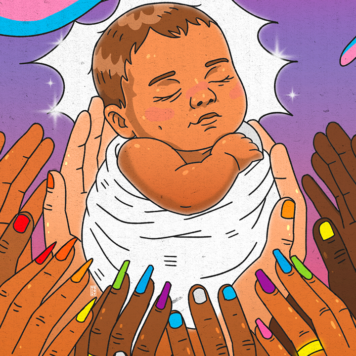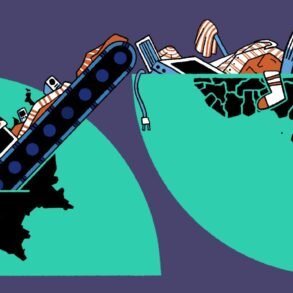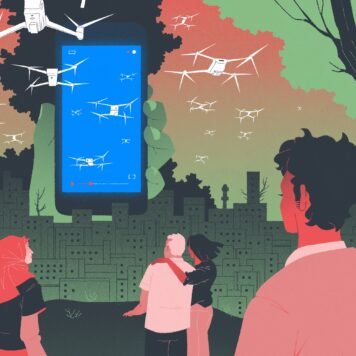Professor Nira Yuval-Davis writes that identities are stories we tell people about who we are and who we are not.
These stories construct the mythology around what we call histories and cultures. Recently the mythology of Afrikanerdom in South Africa has re-entered the global stage, following Donald Trump’s misinformed decision to grant Afrikaners asylum in the US. “South Africa is confiscating land and treating certain classes of people VERY BADLY,” the US President wrote on Truth Social earlier this year.
Trump’s move to encourage Afrikaner resettlement in the US reflects a foundational part of white Afrikaners’ story in post-Apartheid South Africa: that they are a ‘besieged’ group under ‘threat’ from a majority Black government, and more broadly, a majority Black population who together are orchestrating and executing a white genocide and other “very bad things.”
Besiegement and threat are recurring themes in the long story of Afrikanerdom – but it belies a more complex interplay between vulnerability and violence. These logics of threat are driven by the very same white supremacist impulse expressed by Trump, which deems whiteness exceptional and therefore exempt from inconvenience at best, and harm at worst.
Afrikanerdom denotes the institution of Afrikaner hegemony in Southern Africa, originating from early shipwrecked Dutch seafarers who settled at the Cape of Good Hope. Through various socio-political processes that included; enslavement of Indigenous Africans and Asian people, two wars for sovereignty against the British Empire, and apartheid, established in 1948, Afrikaners are the descendants of European explorers and colonisers who formed a new white identity rooted in Africa and tightly tied to the land which they still claim as their hard-earned property.
I sat down with my doctoral supervisor Professor Melissa Steyn, founder of the Wits Centre for Diversity Studies and one of South Africa’s most prominent critical scholars of whiteness.
Melissa and I sit on opposite sides of a historical record of possession and dispossession. Whereas she can trace her lineage in this country all the way back to the first Steyn ancestor, memorialised in the mythology of Dutch settlement in South Africa, I, a descendant of those enslaved at their hands, can only trace mine (barely) three generations back. Between us are endless historical records of pain, violence, othering, enmity and dishonesty. These are the tools used to hammer together the stage on which the production of Afrikaner identity and culture has played out over the last 373 years.
It is not cultural appropriation if you lie about it
The earliest settlement of Dutch colonisers at the Cape in South Africa comprised not of statesmen arriving on the authority of their government, but of castaways from the Netherlands. This obscure fact is often overshadowed by the arrival of the man Afrikaners consider a founding father of their nation – Jan van Riebeeck. Heritage activist Patric Tariq Mellet notes in his book “The Lie of 1652” that even van Riebeeck was not the illustrious colonial clerk he is remembered as:
“In 1647 the Dutch ship Nieuwe Haerlem was wrecked at Table Bay and 62 of the men who had been on board remained at the Cape for more than nine months while waiting for another ship to pick them up […] One of the stranded men, a junior merchant in the service of the VOC called Leendert Janszen used his time at the Cape to gather intelligence […] Janszen made it quite clear that all instances of altercation were a result of ‘the uncivilised and ungrateful conduct of our folk’. In 1648, a fleet of twelve ships took Janszen and the rest of the men back to Holland. On board the same ship as Janszen was a disgraced VOC merchant from the Dutch factory at Tonkin (Hanoi) in Vietnam who had been removed from his post for insider trading in contravention of VOC policy – Jan van Riebeeck.”
The earliest ancestors of white Afrikaners were, amongst others, castaways and disgraced businessmen. This contextualises the origins and exploits of Afrikanerdom through a different lens: the lens of shame – which Professor Steyn has used to contextualise Afrikaner whiteness in her own work.
It is well-known that in South Africa San and Khoi people, who were some of the first to not only interact with but also clash with European colonisers, are the forebears of a sizable proportion of people who are considered Coloured in South Africa today. They are also forebears to Black people who belong to various other ethnic groups in South Africa.
The abduction and trafficking of South-East Asian and African people into slavery at the hands of the Dutch resulted in a creolised Indigenous community who, under conditions of brutality, created a new culture and language. Adept at using the tools of colonialism, it became apparent to Afrikaners that under the guise of collaboration with enslaved and subjugated communities, claiming the language came with great personal benefits. Here started the birth of Afrikaans – a language that later became one of the crown jewels of white Afrikaner culture under apartheid. But how did that come about?
Rewriting history is a colonial methodology
As recently as the 1920s, self-proclaimed Afrikaners were still debating the use of Afrikaans as an official language. A few decades earlier, around the 1880s, the first Arabic-Afrikaans Quran was produced. Even earlier, around the 1830s, enslaved people wrote in the hybrid language made up of Dutch, Bahasa-Melayu and Indigenous Khoe words in the mosque in Cape Town. The original Arabic-Afrikaans was the phonetic spelling of spoken Afrikaans, using the Arabic alphabet which came with enslaved people.
My first question when finding this history was: When did the Dutch learn Arabic?
The answer is they didn’t. The truth about Afrikaans is one of resistance and survival in the face of violent colonial domination, but also erasure and appropriation. Enslaved people at the Cape, which included Indigenous people, created a creole language out of the fragments of their own languages they could quietly hold onto and the dominant language their masters enforced on them.
They did this not only to create new ways to relate to each other under conditions of violence, but also to subvert the prying ears of their oppressors. It was a survival mechanism born out of necessity and creativity. It was not until later, when the Dutch-turned-Afrikaner embarked on their fascist mass-murdering spree which would later be named apartheid, that the descendants of the enslaved tongues were cut out, standardised and used against them.
The very naming of the standardised, whitened language as ‘suiwer’ (pure) Afrikaans set clear terms for who could find identity in this language. This intellectual theft, powered by the ethnonationalism at apartheid’s foundation, relegated the original language to a form of mindless babbling, spoken by equally unsophisticated, child-like people more suited to labour than thought.
This legacy has had lasting consequences for the perceptions held about Coloured people, their cultural practices and their relationship to a language that came to be known as the language of oppression in South Africa.
Whiteness wounds its own first
“The Afrikaners were doing something different from the English. They were trying to declare themselves independent of Europe. So they wanted, I suppose, to have something that they would regard as their own language, which was not a European language,” says Melissa. ”They wanted a language that arose out of the experience of being in Africa – not Africa proper, but as a political statement to distinguish themselves from the Netherlands.”
Although fraught with obscene violence and a lust for power, Afrikaner identity seems to arise out of the same impulse that drives a toddler to exclaim “mine!” when they see something they want. In both instances, the child and the Afrikaner, ignorance operates but for one it is the absence of knowledge, while for the other it is the refusal of knowledge – the knowledge of community.

Join our mailing list
Sign up for shado's picks of the week! Dropping in your inbox every Friday, we share news from inside shado + out, plus job listings, event recommendations and actions ✊
Sign up for shado's picks of the week! Dropping in your inbox every Friday, we share news from inside shado + out, plus job listings, event recommendations and actions ✊
Here, within this struggle for an identity independent from their motherland, appears the first expression of shame. Shame for having been disgraced, shame for having nothing of their own, shame for a lack of proud origin that could be claimed. However, the retention of colonial sensibilities expressed through violence and plunder shows only a partial disidentification with their European origins.
The moment it became apparent that they had nowhere else to go, and that this place was all they had to forge a sense of belonging in, the impulse to nativise themselves and cast off their European associations took flight. Equipped with the violence that gives expression to whiteness, and the wound of shame, they simply claimed the cultural resources of their chattel, since they could identify with its Dutch foundations, and declared themselves white Africans.
This new white essence was slowly established through a deliberate forgetting that faded the cultural contributions of Africans out of memory, as racial boundaries became more opaque and hierarchical, as Melissa explains.
An inconvenient truth that has always stalked Afrikaners throughout their history, is the obvious but denied entanglements with Indigenous and enslaved people. As their white ethno-nationalist project expanded into apartheid, their purported supremacy relied more heavily on a contradictory distancing from both Europe as a motherland, and Africa as a culture. Through this stance they have always been clear that they are white first.
‘Intra-white rivalry’ in the making of an insecure Afrikaner identity
With their new identities barely broken in, they would yet again be made to bow to the authority of Europe as the British crown invaded South Africa not only to exploit its resources and labour, but to establish a new colonial power that subjugated them as “savages with a thin white veneer.”
This enmity between Afrikaner and English white South Africans, or what Melissa refers to as “intra-white rivalry”, has endured to this day. When revisiting their own suffering at the hands of the British, white Afrikaners often speak back through noting how, through their own innovation and industry, they rose to the seat of power again.
The lust for that power was driven by yet another layer of shame: for being outcast, again, by arguably one of the most prominent European architects of whiteness, and having their proud identities eviscerated to the level of the “savages” they had conquered. Erased from this recollection is of course that the rivalry was over the right to oppress and own everyone else, which now detracts from the valiant narrative of perseverance and triumph Afrikaner mythology claims.
As Melissa goes on to explain: “The Afrikaners must have felt very insecure. On the one hand, they were regarded as non-Dutch – which they wanted to think of themselves as. But then the English regarded them as savages.” This, however, did not fit with their plan for their new identity. “Afrikaners still had that European socialisation of wanting to feel high culture. The establishment of ‘Afrikaner kultuur’ was very important to them.”
Afrikaners, Melissa explains, still wanted to distinguish themselves from the people who they believed were without culture. My ancestors and I are these very people. Many people known as Coloured today practice a culture, rich with language, food and forms of self identification, that provide the source for what Afrikaners claim as a culture unique to them. The problem of Afrikanerdom and its history demands a more complex interrogation and reveals a more poignant horror of a wounded, ashamed whiteness that inspired one of the most referenced crimes against humanity, in history.
Violence, vulnerability, and saving whiteness
The story of the Afrikaner becomes a cautionary tale about the life of a shame expressed through the violence licensed by whiteness. The shame of being a conquered people, rejected by their motherland and dismissed, subjugated and looked down upon by their cousins, and again defeated by their former property, is channelled into a lingering violence that has come to be associated with Afrikaner sensibilities.
In our conversation, Melissa notes that Afrikaner culture started as a “shared experience” with Indigenous and enslaved people, yet under unequal power relations. They were the hands and minds who created the rhythm of everyday life needed to establish a society. Indigenous and enslaved people provided the blueprint for a sense of self that could be deemed independent from their European origins – the distinguishing factor Afrikaners so desperately desired.
From language to food, it could have been a truly shared culture, but for the imperial violence of whiteness which is the unique feature of Afrikaner culture that truly distinguishes them from the “savages” they’ve tried so hard to exorcise from their cultural narrative.
This discussion touches the tip of a huge iceberg, but what is clear is that Afrikaner culture exists through the creativity and innovation of African people whom they dispossessed of claims to their own identities. This was the first act of dispossession that later expanded through the theft of land under apartheid.
Now, Afrikaners lament their position through a vulnerability voiced by the language of besiegement, and the enduring promise of violent retaliation in defence of whiteness which has now come to rescue them in the form of white supremacy’s most modern mascot, Donald Trump.
The call Trump has responded to is based on continued claims from white Afrikaner interest groups that opportunistic crimes in rural farming communities are targeted at white farmers because they are white. This narrative has also expanded into claims that land expropriation policies, which seek to redress land theft under colonialism and apartheid is a race based initiative that targets white farmers. Following the logic of threat, this then constitutes a genocide of (white) Afrikaners, who are not only neglected but actively discriminated against based on race.
Melissa and I agree that this, in light of the fact that nobody has ever stepped up to save the victims of their terror, or any Black victims of white supremacist terror, makes yet another statement about the allegiances whiteness beckons, even for its most degraded and disgraced.
Afrikaners have been refugees throughout their history; fleeing from their own shame located in a longstanding geo-political mother wound. If they need saving from anything, it is the dishonesty of their own origin story.
What can you do?
Read:
- The Lie of 1652 by Patric Tariq Mellet
- Khamr: The Makings of a Waterslams by Jamil F. Khan
- Coloured by History, Shaped by Place by Zimitri Erasmus
- Burdened by Race by Mohamed Adhikari
- Regarding Muslims by Gabeba Baderoon
- Rehabilitating a whiteness disgraced: Afrikaner white talk in post‐apartheid South Africa by Melissa Steyn
- Creolisation and Purity: Afrikaans Language Politics in Post-Apartheid Times by C.S. van der Waal
- What is Slavery to Me? Postcolonial/Slave Memory in Post-apartheid South Africa by Pumla Dineo Gqola
Articles about South Africa:
- South Africa just filed a case with the ICJ accusing Israel of “genocidal acts,” but what does this mean?
- Politicians are fuelling the rise of racist mobs in South Africa
Watch:
- Action Kommandant: The Untold Story of the Revolutionary Freedom Fighter Ashley Kriel a documentary by Nadine Cloete
Follow:









